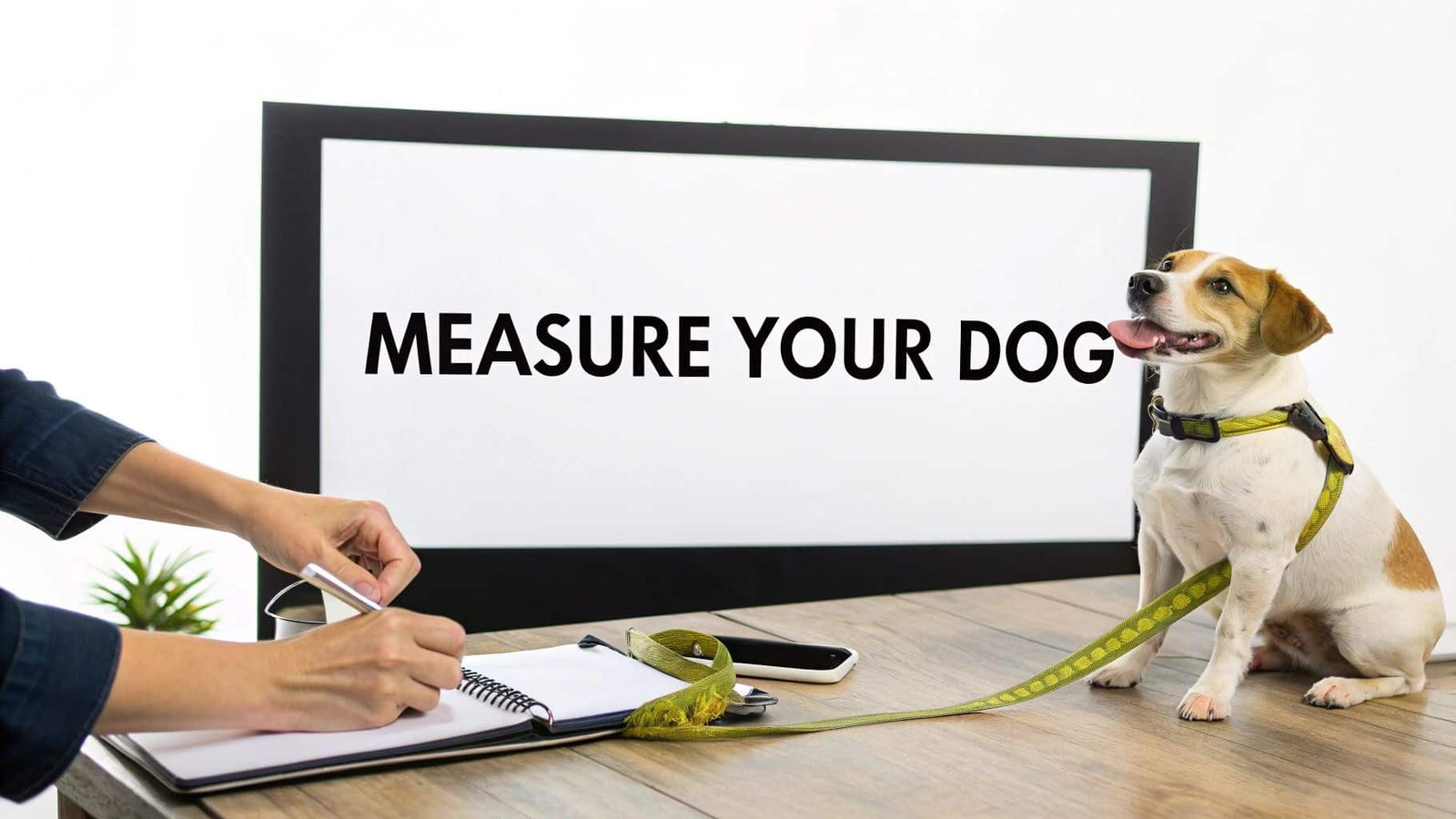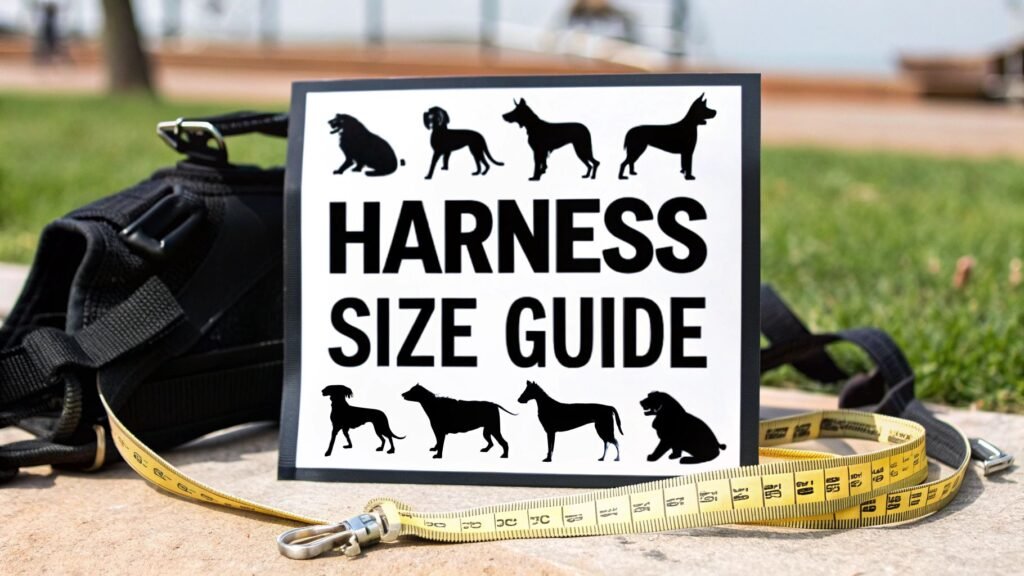How to Measure a Dog for a Harness: Easy Step-by-Step Guide

Getting the right harness for your dog starts with three simple measurements: the chest, the lower neck, and sometimes, the back length. Grab a soft measuring tape, and let’s make sure your dog’s next walk is safe, snug, and super comfortable.
To get started with how to measure a dog for a harness, you’ll want to ensure you have accurate measurements for the best fit.
Why a Perfect Harness Fit Is a Game-Changer
Before we even touch on how to measure, let’s talk about the why. Trust me, this isn’t just about your dog looking sharp at the park. A poorly fitted harness can turn a happy walk into a miserable, even dangerous, experience. It’s one of the most common mistakes I see dog owners make.
When a harness doesn’t fit right, it can cause a whole host of problems—and these aren’t just minor annoyances. Vets and trainers see the fallout from bad fits all the time.
The Real Dangers of a Bad Fit
If a harness is too tight, it’s going to rub and chafe, especially under the front legs and across the chest. This can quickly lead to raw, irritated skin and even infections. More than that, it can physically restrict your dog’s shoulder movement, which messes with their natural stride and could cause joint problems down the road. This is especially critical for brachycephalic (short-nosed) breeds like Pugs and French Bulldogs, where a tight harness can seriously constrict their breathing.
On the flip side, a harness that’s too loose is an escape artist’s dream and a dog owner’s nightmare. A loose harness can easily shift around, creating awkward pressure points. Even worse, your dog could back right out of it, putting them in immediate danger of running into traffic or getting lost.
The whole point of a good harness is to distribute any pulling pressure evenly across the strongest parts of your dog’s body—the chest and sternum. It keeps all that force away from their delicate throat, which is its main advantage over a collar.
It’s All About Comfort and Safety
There’s a reason you’re seeing more harnesses than ever. People are finally getting serious about their pets’ well-being. In fact, the global dog harness market is expected to jump from USD 2.74 billion in 2023 to a whopping USD 7.05 billion by 2031.
This isn’t just about trendy gear; it’s a reflection of our growing understanding of what dogs need to be comfortable and safe. One survey even found that 17% of harness-related injuries were a direct result of bad sizing. You can dig deeper into the dog harness market trends on marketsandata.com.
Spending just a few minutes with a measuring tape isn’t a chore. It’s a simple act of care that makes a huge difference in your dog’s daily life.
Getting Your Tools Ready

Before you start wrestling a measuring tape around your pup, let’s get everything you need in one place. Trust me, being prepared makes the whole process faster and way less stressful for both of you. Getting an accurate measurement is the whole game when it comes to a perfect harness fit.
The best tool for the job is a soft, flexible measuring tape, like the kind a tailor would use. It wraps easily around your dog’s body, giving you a true measurement without any awkward gaps or pinching.
No Soft Tape Measure? No Problem.
If you don’t have one handy, don’t worry. You can easily improvise with a piece of string, a shoelace, or even your phone’s charging cable. Simply wrap it snugly around your dog, pinch the spot where the end meets the rest of the string, and then lay it flat to measure against a rigid ruler or a construction tape measure.
Pro Tip: Keep a handful of your dog’s favorite treats nearby. A little positive reinforcement goes a long way in keeping them calm and cooperative. It turns “measurement time” into “snack time,” which is a win-win.
Lastly, grab a pen and paper or just open the notes app on your phone. You’ll want to jot down the numbers right away so you don’t have to second-guess yourself later.
How to Get the 3 Key Measurements for a Perfect Harness Fit
Alright, let’s get down to the most important part: actually measuring your dog. I promise it’s easier than it sounds. We’re going to focus on three main spots—the chest, the neck, and for some dogs, the back. Nailing these numbers is the secret to finding a harness that’s both safe and comfortable.
Before you start, make sure your dog is standing up straight. A sitting or lying dog will give you wonky measurements every time. This is where those treats come in handy to keep them happy and still. A calm dog is a cooperative dog!
Measuring the Chest Girth
If you only take one measurement, make it this one. The chest girth is the most critical piece of the puzzle for nearly every harness on the market. It’s the circumference of the widest part of your dog’s rib cage.
To find the right spot, feel for the area just behind their front legs. You’re looking for the deepest part of their chest, usually an inch or two back from their “armpits.” Wrap your soft tape measure all the way around, keeping it snug against their body.
The Two-Finger Rule is Your Best Friend
You should be able to comfortably slip two flat fingers between the tape measure and your dog. This little bit of wiggle room ensures the harness won’t be so tight that it chafes, but it’s still secure enough that they can’t back out of it.
This visual guide breaks down exactly where to measure for that perfect, secure fit.

As you can see, the goal is a snug fit with just enough clearance. It’s the difference between a harness that restricts movement and one that’s dangerously loose.
Getting the Neck Circumference Right
Now for the neck. A common mistake I see people make is measuring too high up, right where a normal collar sits. For a harness, you need to go lower.
Measure around the base of the neck, right where it broadens to meet the shoulders. This is the spot where the harness straps will naturally rest. Use that same two-finger rule here to ensure it’s not pressing on their throat. Once you’ve got it, write that number down.
Checking the Back Length
Not all harnesses require a back measurement, but it’s a great number to have on hand. It’s especially important if you have a long-bodied dog like a Dachshund or a Corgi, or if you’re looking at a harness with more back coverage.
To get this one, simply run the tape measure from the base of the neck (that spot between the shoulder blades) straight along their spine to the base of their tail.
To make this even easier, here’s a quick cheat sheet you can reference.
Dog Harness Measurement Cheat Sheet
Use this table as a quick guide to taking the three essential measurements for any dog harness.
| Measurement | Where to Measure | Pro Tip |
|---|---|---|
| Chest Girth | The widest part of the rib cage, 1-2 inches behind the front legs. | This is the make-or-break measurement for a secure fit. Always double-check it. |
| Neck Circumference | Low on the neck, where it meets the shoulders—not high like a collar. | A good fit here prevents choking or pressure on your dog’s trachea. |
| Back Length | From the base of the neck to the base of the tail. | Essential for long-bodied dogs and full-coverage vests to ensure a comfy fit. |
There you have it! With these three numbers jotted down, you’ve got all the info you need to start shopping. You’re ready to confidently compare your dog’s measurements to a brand’s size chart and find that perfect, escape-proof harness.
Measuring Different Dog Body Types

It’s easy to see why a one-size-fits-all approach just doesn’t work for dog harnesses. Imagine a 30-pound Labrador and a 30-pound Dachshund—they share a weight class, but their body shapes are worlds apart. This is exactly why knowing how to measure a dog for a harness means going beyond the scale and looking at their unique build.
Breeds like Greyhounds, Boxers, and Vizslas, for instance, have incredibly deep but narrow chests. For these dogs, the chest girth measurement is the most critical piece of the puzzle. You’ll want to find a harness with a generous amount of strap length between the neck and chest loops. This prevents the dreaded “armpit” chafing that happens when a harness can’t accommodate that chest depth.
Barrel-Chested and Short-Nosed Breeds
Then you have our beloved barrel-chested dogs, like Bulldogs and Pugs. Their wide chests and brawny shoulders can make standard harnesses a real struggle. They often end up being too tight across the front, which can seriously restrict their movement. A Y-shaped harness is usually a great choice here, as it sits lower on the chest and gives their shoulders the freedom they need.
This is even more important for brachycephalic (short-nosed) breeds like Pugs and French Bulldogs. With these dogs making up 8% of the global dog population, it’s clear they need special attention. They are already prone to respiratory issues, and a poorly fitted harness can put dangerous pressure on their sensitive tracheas. In fact, 61% of harness buyers say their top priority is reducing neck strain. If you’re interested in the data, you can read the full report on dog harness market trends.
The Long and Slender Shapes
For the long-bodied pups like Dachshunds and Corgis, the back length measurement is what you really need to focus on. A standard harness often ends too high up on their back, concentrating all the pressure in one spot instead of distributing it evenly. Look for harnesses designed with a longer back piece that provides better support along their spine.
And don’t forget about the fluff! Dogs with thick coats, like German Shepherds and Labrador Retrievers, can be tricky. You have to make sure your measuring tape gets underneath all that fur and sits snugly against their skin. A dense coat can easily add an inch or two to your measurements, resulting in a harness that’s dangerously loose. For more on coat care, take a look at our guide to the best brushes for Labrador Retrievers.
Key Takeaway: Never trust the weight guidelines on a harness package alone. The only way to ensure a truly safe and comfortable fit is to compare your dog’s specific chest, neck, and back measurements to the manufacturer’s size chart. Their unique build is what matters most.
Putting Those Numbers to Work: Choosing the Right Harness

Alright, you’ve got your dog’s measurements. Now for the fun part—shopping! But you’ll quickly discover that harness sizing isn’t standardized across brands. A “medium” from one company can easily be a “large” from another, which is exactly why relying on your own measurements is a non-negotiable first step.
Your most critical measurement is the chest girth. Think of it as the anchor for the entire fit. It’s almost always the main number you’ll see on a sizing chart.
What if your dog is between sizes? My rule of thumb is to always size up. You can easily tighten straps on a slightly larger harness, but you can’t magically add fabric to one that’s digging into your dog’s armpits.
Does the Harness Style Fit Your Dog’s Needs?
Beyond just the size, your measurements can point you toward the best style of harness for your specific dog, especially if you have a puller on your hands.
- Front-Clip Harnesses: These are a trainer’s best friend. The leash clips to a D-ring on your dog’s chest, so when they pull, it gently turns them back toward you. This is a fantastic way to discourage pulling without yanking on their neck.
- Back-Clip Harnesses: Perfect for seasoned walkers and casual strolls. The leash attaches on the back, making them super easy to put on and preventing the leash from tangling under their legs.
- Dual-Clip Harnesses: Why not have both? These offer attachment points on the chest and the back, giving you maximum flexibility. They’re a great long-term investment that adapts as your dog’s training progresses.
Here’s a pro-tip from years of fitting harnesses: I always suggest adding a little buffer to the chest measurement—maybe an inch or two. This wiggle room is crucial for active dogs, ensuring the harness never pinches or restricts their natural movement when they’re running and playing.
Picking the right harness is so much more than grabbing a “medium” off the shelf. When you use your dog’s specific numbers, you can confidently browse a collection of collars, leashes, and harnesses and find a fit that’s genuinely safe, secure, and comfortable for every adventure you two take.
Answering Your Harness Fitting Questions
Even after you’ve got your dog’s measurements down, you might still have a few questions. That’s perfectly normal. Nailing the fit is the final, crucial step, and a bit of hands-on advice can make all the difference.
What If My Dog Is Between Sizes?
This is probably the most common question I get. If your dog’s numbers land squarely between two sizes on the chart, always size up.
It’s much easier to tighten a slightly larger harness than it is to stretch one that’s too small. A harness that’s too snug is a non-starter—it leaves zero room for adjustment and can quickly cause painful chafing or even restrict your dog’s breathing and movement. A good harness will have plenty of adjustable straps to help you get that custom-like fit.
How Do I Know the Fit Is Just Right?
Once you have the harness on your dog, the real test begins. The best trick in the book is the classic “two-finger rule.”
You should be able to slide two fingers comfortably between the harness and your dog’s body at any point. This applies to the straps around the neck, behind the front legs, and across the chest.
The goal is a snug fit, not a tight one. Your dog should have a full range of motion without the harness shifting or rotating wildly as they move. A well-fitted harness stays put.
Take a moment to watch your dog walk, run, and sit in it. Do they look comfortable? Or are they moving awkwardly? Sometimes a few minor tweaks are all it takes. For a great example of how a harness should sit, take a look at the fit on this tactical dog harness.
Do I Measure a Puppy Differently?
Absolutely. Puppies are a whole different ball game because they grow so quickly. For a young, growing pup, your best bet is to find a harness with a ton of adjustability.
You’ll want to re-measure them every couple of weeks to keep up with their growth spurts. Many people start with a more basic, budget-friendly harness that can expand, then invest in a higher-quality one once their dog is nearly full-grown.
At Ur Pet Store, we know a great fit means a happy dog. Find the perfect harness for your next adventure at https://urpetstore.com.


